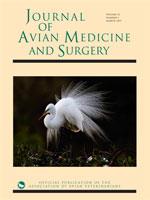Four captive raptors, an American kestrel (Falco sparverius), peregrine falcon (Falco peregrinus), golden eagle (Aquila chrysaetos), and barn owl (Tyto alba), were diagnosed with ventricular and/or proventricular foreign material impactions consisting of artificial turf substrate, paper and plastic substrate, grass, and newspaper. Partial or total anorexia was reported in all birds and decreased casting in 2 birds. Survey radiographs confirmed presence of gastric enlargement in all 4 birds. The kestrel and eagle were treated unsuccessfully with gastroscopy and gastric lavage, respectively, followed by surgical intervention to remove the ventricular impactions. Both birds died of undetermined causes after surgery. The peregrine falcon died before medical or surgical intervention was started, and the owl was managed successfully with oral mineral oil and liquid diet to facilitate egestion of the foreign material as a pellet. Lead poisoning was suspected as the predisposing cause for foreign body ingestion in the eagle, but underlying causes for pica in the other birds were not determined. Radiographs can provide useful diagnostic information in sick raptors that exhibit vomiting or changes in appetite or casting frequency, and may help guide treatment decisions of impacted birds. Careful consideration of substrate, enrichment items, and access to potential foreign material that could be ingested may be the best pre-emptive management strategy in captive raptors.
How to translate text using browser tools
1 March 2017
Management and Case Outcome of Gastric Impaction in Four Raptors: A Case Series
Jeffrey R. Applegate,
Arnaud Van Wettere,
Emily F. Christiansen,
Laurel A. Degernes
ACCESS THE FULL ARTICLE
Avian
gastric impaction
gastrointestinal foreign body
raptor





